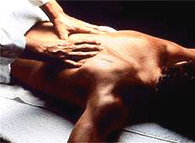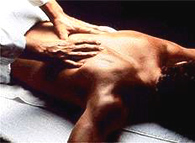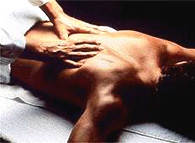What's the hype on massage and stretching?
Any gym junkie will be all too familiar with the big-muscle-small-brains type in the gym harping on you for stretching too much. "Don't stretch so much or you won't grow big and strong like me..." Many wouldn't have a clue how to defend oneself on such an "intellectual" onslaught! Which would be quite a pity, since any girl worth her worth in Prada bags should have a quick and rehearsed retort in all situations... shoes, clothes, men... you get the gist. Well fear not! Here's some fodder for the glib and glam. Read on to get the low down on stretching (and not "getting it on by stretching low down").

Stretching And Recovery
Stretching is useful for both injury prevention and injury treatment. If done properly, stretching increases flexibility and this directly translates into reduced risk of injury. The reason is that a muscle/tendon group with a greater range of motion passively, will be less likely to experience tears when used actively. Stretching is also thought to improve recovery and may enhance athletic performance. In addition, increased flexibility of the neck, shoulders and upper back may improve your breathing ability.
The effectiveness of the stretching exercise will depend on the tissues being stretched. 'Warm up, stretch slowly, cool' is the formula that can be applied for the most effective stretching. Safety should always come first. The starting position, method and dosage should be specific for the athlete and must be understood completely by the athlete.
Proposed Stretching Benefits
- Reduced muscle soreness
- Increase Flexibility
- Increase muscle relaxation
- Prevent excessive adhesion formation (tightness)
- Increase blood and nutrient flow to tissues and throughout body
- Improved muscle coordination
- Reduce muscle resistance

Unfortunately, stretching in general has not been consistently proven to prevent soreness or injury, or increase strength. So there you go! More reasons why you should stretch often. The "stretch so you can get to positions and reach higher levels of the karma sutra" routine is getting old. Try these other new reasons next time.
Massage and recovery
Regular massage makes an important contribution to tissue recovery from intense athletic activity. To understand the mechanism of this effect it is important to understand the soft tissue effects of intense training.
Effects of hard training on soft tissue
Intense training causes excessively prolonged elevation of muscle tone both in resting and contracted states. This may involve the entire muscle or groups of muscle fibers forming taut bands. This is often felt as muscle 'tightness' by the athletes themselves and occurs particularly during periods of adaptation to increased volume and intensity of training.
Intense training also causes irritation of previous inadequately resolved soft tissue injuries. Repetitive micro-trauma of these injuries may result in the laying down of excessive bulky non-muscle tissue, compromising muscle function and reducing flexibility. Heavy training also predisposes to the development of active trigger points (painful spots) that may result in the reduction of muscle strength and efficiency. These problems will impair both training and competition performance and can progress to injury with continued training unless they are resolved.
Through rhythmically applying pressure and stretching to the soft tissues of the body, there is stimulation of receptors in tendons, muscles, deep tissues and the organs. As well as improving soft tissue function, regular massage provides the opportunity for the masseur to identify any soft tissue abnormalities, which, if untreated, may progress to injury. The masseur may be able to correct these abnormalities with soft tissue techniques or, alternatively, refer the athlete to other members of the sports medicine team as appropriate. The masseur should be alert to problems such as excessive tiredness, inadequate nutrition or musculoskeletal symptoms, such as bone pain, of which the athlete may complain. If possible, massage should be incorporated in the warm-down program to maximize recovery for athletes who need to compete again after a relatively short interval.

Massage can
- reduce excessive post-exercise muscle tone/ spasm,
- decrease detrimental effects of training (eg. Strain and discomfort)
- increase muscle range of motion,
improve training consistency
- prevent muscle and tendon injury
- increase the circulation and nutrition to damaged tissue
- assist acute injury healing (prevent chronicity)
- assist chronic injury healing
- deactivate symptomatic trigger points.
Training/post-event massage
Massage techniques that slowly stroke the tissues and knead the muscles are widely used, particularly by the Russians, in training sessions (10-30 min for relaxation) or events for their ability to improve potential performance and recovery. The area showing most gain was that of strength. Furthermore, massage techniques (light after heavy activities, deeper for light workloads and lasting 30-60 min) have been shown to be two to three times more likely to promote recovery than resting. Psychologically and emotionally, massage can be used to enhance a feeling of well-being and relaxation. It should be given up to eight hours after the event when lighter techniques are used and one or two days later for heavier techniques.
So now you have "scientific" excuse for going to your favorite masseur next time someone accuses you of being a sloth and paying too much attention to self-indulgence.
Disclaimer: In The Pink/Fridae will not be held liable for any social disharmony that may result from following these facts though. Hey we give you the goods, you do what's good for you!











 列印版本
列印版本










讀者回應
搶先發表第一個回應吧!
請先登入再使用此功能。